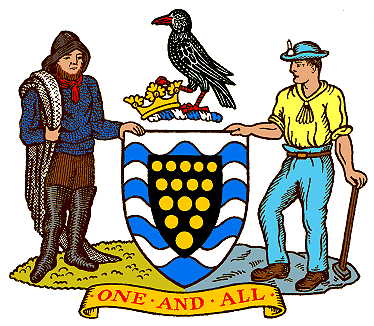Cornwall (county)
| Heraldry of the World |
| British heraldry portal Civic heraldry of the United Kingdom |
|
CORNWALL County and Unitary Authority
Additions : 2009 Caradon (1974 Liskeard (borough), Liskeard RDC, Looe UDC, Saltash (borough), St. Germans RDC, Torpoint UDC), Carrick (1974 Falmouth, Penryn, Truro, Truro RDC), Kerrier (1974 Camborne-Redruth UDC, Helston (Borough), Kerrier RDC), North Cornwall (1974 Bodmin, Bude-Stratton UDC, Camelford RDC, Launceston (borough), Launceston RDC, Stratton RDC, Wadebridge and Padstow RDC), Penwith (1974 Penzance (Borough), Saint Ives (Borough), Saint Just UDC, West Penwith RDC), Restormel (1974 Newquay UDC, St. Austell with Fowey Borough, St. Austell RDC)
Official blazon
Arms : Sable fifteen Bezants in pile within a Bordure barry wavy of eight Argent and Azure.
Crest : On a Wreath Argent and Azure a Chough proper resting the dexter claw upon a Ducal Coronet Or.
Supporters : On the dexter side a Fisherman holding over the exterior shoulder a Net and on the sinister side a Miner resting the exterior hand on a Sledge Hammer all proper.
Motto: 'ONE AND ALL'
Origin/meaning
The arms were officially granted on April 5, 1939.
A bearded sea fisherman represents the county's maritime connections, and he stands opposite the tin miner, a reminder of Cornwall's great mineral wealth and pioneering industrial heritage. Above the shield rests the Chough, a relative of the Jackdaw with blue-black plumage and a distinctive curved red bill. The Chough used to proliferate on the cliffs of Cornwall, but is now almost extinct in the county, although conservationists are working to re-establish it through breeding in captivity. The bird rests its claw on a Ducal Coronet. The Duchy of Cornwall, which includes land in Devon, London (for example, the Oval cricket ground) and the Scilly Isles, has long been the inheritance of the sovereign's eldest son, as is the title of Duke of Cornwall.
Like the county itself, the shield is enclosed by waves, and at its heart is the history and mystery of the golden roundels or 'bezants'. Many fanciful guesses have been made about their origin, although no-one is really certain how the county came to adopt such a bold graphic symbol. Nowadays 15 bezants appear arranged in an inverted triangle, but earlier Cornish emblems show them used as a border, or arranged to fill a whole shield.
Among the more colourful conjectures is the tale of the King's eldest son, captured by Saracens during the Crusades. Loyal Cornishmen, it is said, helped to raise the ransom of 15 golden coins, or bezants, named after Eastern Europe's Byzantium. The shield is thought to commemorate this King's (or more properly, Prince's) ransom, with the legend 'one and all' noting a splendid joint effort by Cornishmen to save their Duke of Cornwall. Whether referring to this particular event or not, this well-known phrase still indicates Cornwall's community spirit, but is also the very best description of a Cornish welcome.
Contact and Support
Partners:
Your logo here ?
Contact us
© since 1995, Heraldry of the World, Ralf Hartemink 
Index of the site
Literature : Briggs, 1971 and the County website; Elvins, 1991.












